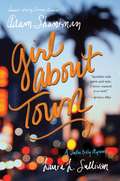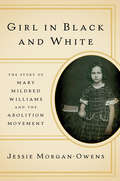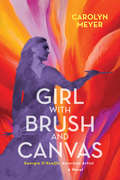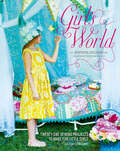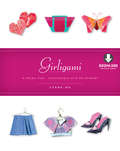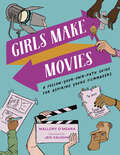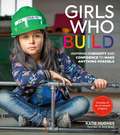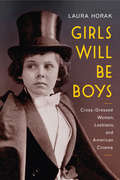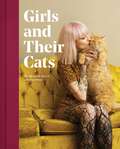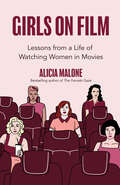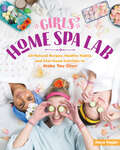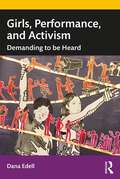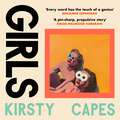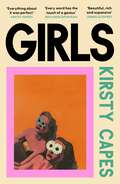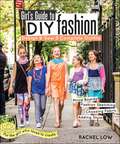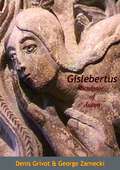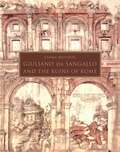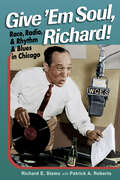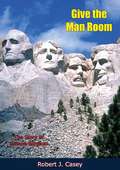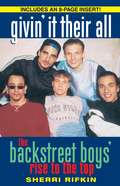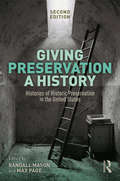- Table View
- List View
Girl about Town
by Laura L. Sullivan Adam Shankman“Cinematic pacing, a compelling whodunit, and the glitzy aura of golden age Hollywood combine in this star-studded novel” (Booklist) from acclaimed film producer/director Adam Shankman and coauthor Laura Sullivan.Not too long ago, Lucille O’Malley was living in a tenement in New York. Now she’s Lulu Kelly, Hollywood’s newest It Girl. She may be a star, but she worries that her past will catch up with her. Back in New York she witnessed a Mafia murder, and this glamorous new life in Tinseltown is payment for her silence. Dashing Freddie van der Waals, the only son of a New York tycoon, was a playboy with the world at his feet. But when he discovered how his corrupt father really made the family fortune, Freddie abandoned his billions and became a vagabond. He travels the country in search of redemption and a new identity, but his father will stop at nothing to bring him home. When fate brings Lulu and Freddie together, sparks fly—and gunshots follow. Suddenly Lulu finds herself framed for attempted murder. Together, she and Freddie set out to clear her name. But can they escape their pasts and finally find the Hollywood ending they long for?
Girl in Black and White: The Story Of Mary Mildred Williams And The Abolition Movement
by Jessie Morgan-OwensThe riveting, little-known story of Mary Mildred Williams—a slave girl who looked “white”—whose photograph transformed the abolitionist movement. When a decades-long court battle resulted in her family’s freedom in 1855, seven-year-old Mary Mildred Williams unexpectedly became the face of American slavery. Famous abolitionists Thomas Wentworth Higginson, Henry David Thoreau, and John Albion Andrew would help Mary and her family in freedom, but Senator Charles Sumner saw a monumental political opportunity. Due to generations of sexual violence, Mary’s skin was so light that she “passed” as white, and this fact would make her the key to his white audience’s sympathy. During his sold-out abolitionist lecture series, Sumner paraded Mary in front of rapt audiences as evidence that slavery was not bounded by race. Weaving together long-overlooked primary sources and arresting images, including the daguerreotype that turned Mary into the poster child of a movement, Jessie Morgan-Owens investigates tangled generations of sexual enslavement and the fraught politics that led Mary to Sumner. She follows Mary’s story through the lives of her determined mother and grandmother to her own adulthood, parallel to the story of the antislavery movement and the eventual signing of the Emancipation Proclamation. Girl in Black and White restores Mary to her rightful place in history and uncovers a dramatic narrative of travels along the Underground Railroad, relationships tested by oppression, and the struggles of life after emancipation. The result is an exposé of the thorny racial politics of the abolitionist movement and the pervasive colorism that dictated where white sympathy lay—one that sheds light on a shameful legacy that still affects us profoundly today.
Girl in a Band (10th Anniversary Edition): A Memoir
by Kim GordonNEW YORK TIMES BESTSELLERKim Gordon, founding member of Sonic Youth, fashion icon, and role model for a generation of women, now tells her story—a memoir of life as an artist, of music, marriage, motherhood, independence, and as one of the first women of rock and roll, written with the lyricism and haunting beauty of Patti Smith's Just Kids.Often described as aloof, Kim Gordon opens up as never before in Girl in a Band. Telling the story of her family, growing up in California in the '60s and '70s, her life in visual art, her move to New York City, the men in her life, her marriage, her relationship with her daughter, her music, and her band, Girl in a Band is a rich and beautifully written memoir.Gordon takes us back to the lost New York of the 1980s and '90s that gave rise to Sonic Youth, and the Alternative revolution in popular music. The band helped build a vocabulary of music—paving the way for Nirvana, Hole, Smashing Pumpkins and many other acts. But at its core, Girl in a Band examines the route from girl to woman in uncharted territory, music, art career, what partnership means—and what happens when that identity dissolves.Evocative and edgy, filled with the sights and sounds of a changing world and a transformative life, Girl in a Band is the fascinating chronicle of a remarkable journey and an extraordinary artist.
Girl with Brush and Canvas: Georgia O'Keefe, American Artist
by Carolyn MeyerThe life of artist Georgia O'Keeffe is revealed in this biographical novel -- from her childhood when she decided to be an artist, through her art education in Chicago and New York, to her eventual rise to fame in the American Southwest. <P><P> At the age of 12, Georgia O'Keeffe announced that she wanted to be an artist. With the support of her family, O'Keeffe attended boarding schools with strong art programs, and after graduating, went to live with an aunt and uncle in Chicago to attend the city's highly regarded Art Institute. Illness forced O'Keeffe to leave Chicago, but once she'd recovered, her family scraped together funds to send her to New York to study at the Art Students League. When her family fell on hard times, she left without the degree she needed. Discouraged, but unwilling to give up her dream, O'Keeffe found a different path. She became an art teacher in schools in Texas and South Carolina, honing her own craft as she taught her students. O'Keeffe never gave up her dream, no matter what obstacles she encountered--she knew she was meant to be an artist.
Girl's World: Twenty-One Sewing Projects to Make for Little Girls
by Tim Geaney Jennifer PaganelliJennifer Paganelli designs one of the most popular fabric lines in the crafting marketplace. In Girl's World, her debut book, she presents twenty-one adorable sewing projects to make for little girlsfrilly dresses, ruffled pillows, bed canopies, stuffed animals, and more! Each project features Jennifer's fresh, feminine flair in sizes and styles perfect for toddlers to tweens. With step-by-step instructions, a comprehensive techniques section, and simple sizing charts ranging from extra-small to extra-large, this ebook is exceptionally easy to use. Featuring whimsical design, lush color photos, and downloadable patterns, Girl's World makes sewing girly goodies a joy for crafters of all levels.
Girligami
by Cindy NgA fun new twist on the ancient art of origami! From sweet and swirly ice cream to a retro phone to a crafty kitty to sassy pumps, Girligami is packed with fun and fashionable folding projects. Inside, girls will find colorful, easy-to-follow folding instructions and origami paper for each of the 12 dazzling projects. Forgo the usual Valentine’s Day card and hand out cute origami Valentine hearts. Liven up the refrigerator by turning origami projects into colorful magnets, create pretty hanging notepads with the creations, and more! Girligami has everything girls need. Get ready for endless folding fun!
Girligami
by Cindy NgMake fresh and fashionable origami projects for girls with this fun origami kit! This new modern and contemporary paper craft kit is origami with a sassy twist-a box full of fun that lets crafters turn bits of paper into 3D origami fashion, romance and all things cute and pretty. Each of the custom-designed origami projects take only a minute to make and are a great way to learn origami. The full-color origami book gives clear step-by-step instructions on how to make each 3D origami model. And it has an added section showing origami paper folders how to turn their paper creations into cool earrings, greeting cards and other useful and not-so-useful (but no less fun) things folders can give to their friends. The glossy, custom-patterned origami folding sheets are all imprinted with guidelines for easy, foolproof folding This easy origami kit contains: 18 easy-to-do origami projects 50 fabulous paper folding designs 64 page full color booklet Step-by-step instructions An introduction to paper folding and guidelines for foolproof folding Origami projects include: Foxy Pumps Strapless Dress Lacy Jacket Bobo Panda Lola Kitty Cool Cupcake Secret Love Note Vogue-It Earrings And many more...
Girligami
by Cindy NgMake fresh and fashionable origami projects for girls with this fun origami kit!This new modern and contemporary paper craft kit is origami with a sassy twist-a box full of fun that lets crafters turn bits of paper into 3D origami fashion, romance and all things cute and pretty. Each of the custom-designed origami projects take only a minute to make and are a great way to learn origami. The full-color origami book gives clear step-by-step instructions on how to make each 3D origami model. And it has an added section showing origami paper folders how to turn their paper creations into cool earrings, greeting cards and other useful and not-so-useful (but no less fun) things folders can give to their friends. The glossy, custom-patterned origami folding sheets are all imprinted with guidelines for easy, foolproof foldingThis easy origami kit contains: 18 easy-to-do origami projects 50 fabulous paper folding designs 64 page full color booklet Step-by-step instructions An introduction to paper folding and guidelines for foolproof foldingOrigami projects include:Foxy PumpsStrapless DressLacy JacketBobo PandaLola KittyCool CupcakeSecret Love NoteVogue-It EarringsAnd many more...
Girls Make Movies: A Follow-Your-Own-Path Guide for Aspiring Young Filmmakers
by Mallory O'MearaMake your own movie from start to finish with this entertaining, practical choose-your-path nonfiction guide to the world of filmmaking, from the critically acclaimed author of The Lady from the Black Lagoon. <p><p>Girls belong in the world of filmmaking. While we see them acting on-screen, there are also countless women working every single job possible behind the scenes as part of the film's crew. Are you a girl who is interested in film making? Do you wonder how you actually make a movie? Well, this is the book for you. <p><p>Girls Make Movies puts you in the driver'’s seat as you create a fictitious zombie blockbuster and are guided through each stage of production and learn about the processes, techniques, and people involved in making a Hollywood hit. Luckily, every path through this nonfiction book results in the film being made, but you will be asked to make choices that will affect the outcome of the movie. Will you shoot on location or on a studio lot? Use practical or special effects? Hire a greensperson or a someone to do pyrotechnics? The choices are up to you! <p><p>Written by critically acclaimed author Mallory O'Meara and paired with eye-catching, graphic illustrations by popular comic book artist Jen Vaugh, this unique, practical book provides young girls with advice and inspiration while offering a sense of adventure as they learn how to create a movie!
Girls Who Build: Inspiring Curiosity and Confidence to Make Anything Possible
by Katie HughesCelebrate the can-do attitude of fierce girls who know how to wield a hammer, fire up a saw, and build everything from a bookshelf to a playhouse. Featuring project photographs, this guide will inspire you to pick up your power tools and make something great.Carpenter Katie Hughes frequently found that she was the only woman on construction worksites. To change that, she began teaching classes to girls ages 8-14, showing them how to drill, saw, and weld. Her classes quickly became sold out summer camps and she founded her own non-profit, Girls Build.Girls Who Build features candid and arresting photographs of forty-five girls showing off their power tools and can-do attitudes. Accompanying each girl is a profile interview where she speaks to her inspirations and favorite builds, plus tips for others starting out. Also included are building skills, techniques, and safety tips to teach girls -- and older beginners -- how to handle hammers, drills, and saws plus thirteen do-it-herself building projects (from the featured girls themselves) such as picture frames, nightstands, playhouses, and more.
Girls Will Be Boys
by Laura HorakMarlene Dietrich, Greta Garbo, and Katharine Hepburn all made lasting impressions with the cinematic cross-dressing they performed onscreen. What few modern viewers realize, however, is that these seemingly daring performances of the 1930s actually came at the tail end of a long wave of gender-bending films that included more than 400 movies featuring women dressed as men. Laura Horak spent a decade scouring film archives worldwide, looking at American films made between 1908 and 1934, and what she discovered could revolutionize our understanding of gender roles in the early twentieth century. Questioning the assumption that cross-dressing women were automatically viewed as transgressive, she finds that these figures were popularly regarded as wholesome and regularly appeared onscreen in the 1910s, thus lending greater respectability to the fledgling film industry. Horak also explores how and why this perception of cross-dressed women began to change in the 1920s and early 1930s, examining how cinema played a pivotal part in the representation of lesbian identity. Girls Will Be Boys excavates a rich history of gender-bending film roles, enabling readers to appreciate the wide array of masculinities that these actresses performed--from sentimental boyhood to rugged virility to gentlemanly refinement. Taking us on a guided tour through a treasure-trove of vintage images, Girls Will Be Boys helps us view the histories of gender, sexuality, and film through fresh eyes.
Girls and Their Cats
by Elyse Moody Brianne WillsGirls and Their Cats showcases 50 strong, independent, and artistic women who take the world in stride with their beloved felines.This stunning book redefines what it means to be a "cat lady" through striking portraits and engaging profiles of each woman and her cat—or cats.Interspersed throughout are amusing lists any cat lady will find relatable, from "How to Catproof Your Home" to "The Chorus of Cat Sounds," as well as an adoption resource guide and a list of rescue organizations in the United States and Canada.• Includes heartwarming stories about each woman and her furry friend, as well as fun facts• Celebrates the powerful bond between a girl and her cat, proving that we need them just as much as they need us• Based on the popular Instagram @girlsandtheircats, which has been featured on Buzzfeed, Refinery29, The Daily Mail, and moreFor the authors—BriAnne Wills, New York City fashion and beauty photographer, and Elyse Moody, senior editor at Martha Stewart Living—the "crazy cat lady" stereotype is a myth.Girls and Their Cats includes inspirational ladies like Hannah Shaw, founder of the neonatal kitten rescue project Kitten Lady, Christene Barberich, cofounder of Refinery29, and Alyssa Mastromonaco, Crooked Media podcast host and reproductive rights activist.• Great for cat lovers, feminists, fashion enthusiasts, photography buffs, interior designers, and anyone who loves a good animal-human friendship• Features a vibrant cover and a gorgeous faux-suede spine, making it a beautiful coffee table book or deluxe gift• Add it to the shelf with books like Shop Cats of New, The French Cat, Tiny But Mighty, The Lion in Your Living Room, and In the Company of Women: Inspiration and Advice from over 100 Makers, Artists, and Entrepreneurs by Grace Bonney
Girls on Film: Lessons from a Life of Watching Women in Movies
by Alicia MaloneGirls on Film: Witty Life Lessons from Alicia Malone#1 Best Seller in Photography Criticism & Essays, Movie Guides & Reviews, Movie ReferenceWith humor and honesty, Girls on Film looks at the good, the bad, and the unfairly written women in film. This collection celebrates the power of cinema, media, culture and the faces of girls on film.Insiders from a Nerdy Film Lover. Weaving together life lessons with movie history, film reporter Alicia Malone celebrates the power of cinema and the women who shone brightly on the big screen, while also critiquing hidden messages in films. Alicia connects film analysis with her own journey of self-discovery —from growing up as a nerdy film lover in Australia to finding her voice as a woman on television.Each Movie has a Hidden Message. What messages and life lessons have been taken from these movies of the past —positive, negative or sometimes, both? Alicia Malone highlights many films, some with life changing moments and others with a tribute to feminist authors and messages.In this modern approach to film reviews and women, you’ll find essays on:Hidden messaging and life lessons in filmsThe journey of women's history in filmBreakdowns on movie stereotypes like the the femme fataleWomen nonfiction lovers who enjoyed Where the Girls Are, or feminism books like Extraordinary Women In History, When Women Invented Television, or Renegade Women in Film and TV, will love Girls on Film.
Girls' Home Spa Lab: All-Natural Recipes, Healthy Habits, and Feel-Good Activities to Make You Glow
by Maya PagánFor today’s active, plugged-in girls aged 9 to 13, finding healthy ways to unwind and de-stress is an important part of well-being. Girls’ Home Spa Lab is packed with all-natural recipes, activities, and tips for self-care and relaxation specially designed for tweens. From homemade facial steams and hair masks to foot soaks, tub teas, and body balms, the 50 head-to-toe recipes can be easily made from ingredients found in the kitchen cupboard, such as honey, oats, and coconut oil. Girls will also learn how to soothe themselves with easy yoga poses, homemade sleep tea, and natural remedies for a headache, stuffy nose, or sore throat. Maya Pagán’s upbeat voice encourages girls to explore their creativity and develop self-confidence while having fun mixing up their own spa treatments.
Girls, Performance, and Activism: Demanding to be Heard
by Dana EdellGirls, Performance, and Activism offers artists, activists, educators, and scholars a comprehensive analysis, celebration, and critique of the ways in which teenage girls create and perform activist theater. Girls, particularly Black and Latinx teenagers, are using the tools of performance to share their stories, devise new ones, and use the stage to advocate for social change. Interweaving interviews, poetic text, drama, and theory, this book provides readers with a comprehensive understanding of how and why this field erupted and the ways in which girls are using performance to transform themselves and enact change in their communities. As a white woman who has collaboratively created theater with hundreds of girls of color over the past 20 years, Dana Edell offers strategies for engaging with girls across difference through an intersectional lens in order to acknowledge the ways in which race, gender, age, class, ability, and sexuality influence girls’ experiences and relationships with adult collaborators as they work to create meaningful, impactful, and often personal activist performances. This is the go-to handbook for teachers, theater directors, and performance makers who want to create politically engaged work with teenage girls.
Girls: The stunning new novel from the Women’s Prize longlisted author of CARELESS
by Kirsty Capes*Don't miss the searing, dazzling and unforgettable new novel from the Women's Prize longlisted author of CARELESS!*'Every word has the touch of a genius' BENJAMIN ZEPHANIAH'Expect to see this on every sun lounger this summer!' THE SHIFT'A pin-sharp, propulsive story' KIRAN MILLWOOD HARGRAVE'Daisy Jones and the Six fans will love this!' GRAZIA'I was bereft when I finished. A contender for my books of the year list' PRIMA'Bold, brilliant, shocking and shattering' CHRIS WHITAKEREveryone has heard of Girls.But what happened to the women they became?At the time of her death, the press wrote many things about Ingrid Olssen:She was a brilliant artist. She was a terrible mother to her girls, Mattie and Nora. And that her legacy would live on forever.Even so, it's unlikely the world will ever see another Ingrid Olssen exhibition - her last request to her daughters was to throw her ashes in the canyon and her paintings in the sea.But as Mattie and Nora reluctantly embark on an all-or-nothing trip to fulfil her wishes, they start to unpick the painful scars of their past.And soon they begin to realise that the ties that bound them, might also break them...Perfect for fans of Sorrow and Bliss by Meg Mason and Daisy Jones and the Six by Taylor Jenkins Reid. GIRLS is as devastating as it is hilarious, as tender and moving as it is shocking - this is a book that will stay with you long after you have turned the final pages.** PRAISE FOR GIRLS **'I knew I'd love GIRLS and I did, but I'm also utterly devastated by it. What a beautiful, rich, expansive novel. It'll be a while before I stop crying. Thank you a million times over' JENNIE GODFREY'I can't think when I last encountered a story world of this depth and faultless plausibility. Everything about it was perfect: intricate; warm; uncluttered. Blimey, I wish I'd written it' ANSTEY HARRIS'An extraordinary writer of lives rarely written about [...] in words that are wise, warm, painful and often witty' DALJIT NAGRA'Raw, vivid, complex, painful and unexpectedly funny too - a brilliantly original novel that really gets under your skin' JOANNA GLEN'Phenomenal. I loved it.' KATE SAWYER'Surprising, heart-breaking and dryly funny, Kirsty Capes is such an exciting talent.' CAROLINE HULSE'GIRLS puts a lens to the awful things sisters do to one another and the absolute life-changing necessity of a sister's forgiveness.' ABIGAIL BERGSTROM'Ambitious in form and scope, it covers childhood trauma, art and celebrity culture, the unfathomable bond between sisters, and much more' ELISSA SOAVE'Unmissable, bold and moving. This is Capes' best novel yet.' SARA JAFARI'Thoughtful and deeply human, Girls is a masterful take on family at its most complicated' PHOENICIA ROGERSON'Phenomenal. GIRLS made me laugh, cry, and gave me all the feels in between. I'll be thinking about these characters for a very long time' LISA HALL'Wonderful, wonderful storytelling and unforgettable characters' SARA NISHA ADAMS
Girls: The stunning new novel from the Women’s Prize longlisted author of CARELESS
by Kirsty Capes*Don't miss the searing, dazzling and unforgettable new novel from the Women's Prize longlisted author of CARELESS!*'Every word has the touch of a genius' BENJAMIN ZEPHANIAH'Expect to see this on every sun lounger this summer!' THE SHIFT'A pin-sharp, propulsive story' KIRAN MILLWOOD HARGRAVE'Daisy Jones and the Six fans will love this!' GRAZIA'I was bereft when I finished. A contender for my books of the year list' PRIMA'Bold, brilliant, shocking and shattering' CHRIS WHITAKEREveryone has heard of Girls.But what happened to the women they became?At the time of her death, the press wrote many things about Ingrid Olssen:She was a brilliant artist. She was a terrible mother to her girls, Mattie and Nora. And that her legacy would live on forever.Even so, it's unlikely the world will ever see another Ingrid Olssen exhibition - her last request to her daughters was to throw her ashes in the canyon and her paintings in the sea.But as Mattie and Nora reluctantly embark on an all-or-nothing trip to fulfil her wishes, they start to unpick the painful scars of their past.And soon they begin to realise that the ties that bound them, might also break them...Perfect for fans of Sorrow and Bliss by Meg Mason and Daisy Jones and the Six by Taylor Jenkins Reid. GIRLS is as devastating as it is hilarious, as tender and moving as it is shocking - this is a book that will stay with you long after you have turned the final pages.** PRAISE FOR GIRLS **'I knew I'd love GIRLS and I did, but I'm also utterly devastated by it. What a beautiful, rich, expansive novel. It'll be a while before I stop crying. Thank you a million times over' JENNIE GODFREY'I can't think when I last encountered a story world of this depth and faultless plausibility. Everything about it was perfect: intricate; warm; uncluttered. Blimey, I wish I'd written it' ANSTEY HARRIS'An extraordinary writer of lives rarely written about [...] in words that are wise, warm, painful and often witty' DALJIT NAGRA'Raw, vivid, complex, painful and unexpectedly funny too - a brilliantly original novel that really gets under your skin' JOANNA GLEN'Phenomenal. I loved it.' KATE SAWYER'Surprising, heart-breaking and dryly funny, Kirsty Capes is such an exciting talent.' CAROLINE HULSE'GIRLS puts a lens to the awful things sisters do to one another and the absolute life-changing necessity of a sister's forgiveness.' ABIGAIL BERGSTROM'Ambitious in form and scope, it covers childhood trauma, art and celebrity culture, the unfathomable bond between sisters, and much more' ELISSA SOAVE'Unmissable, bold and moving. This is Capes' best novel yet.' SARA JAFARI'Thoughtful and deeply human, Girls is a masterful take on family at its most complicated' PHOENICIA ROGERSON'Phenomenal. GIRLS made me laugh, cry, and gave me all the feels in between. I'll be thinking about these characters for a very long time' LISA HALL'Wonderful, wonderful storytelling and unforgettable characters' SARA NISHA ADAMS
Girls: The stunning new novel from the Women’s Prize longlisted author of CARELESS
by Kirsty Capes*Don't miss the searing, dazzling and unforgettable new novel from the Women's Prize longlisted author of CARELESS!*'Every word has the touch of a genius' BENJAMIN ZEPHANIAH'Expect to see this on every sun lounger this summer!' THE SHIFT'A pin-sharp, propulsive story' KIRAN MILLWOOD HARGRAVE'Daisy Jones and the Six fans will love this!' GRAZIA'I was bereft when I finished. A contender for my books of the year list' PRIMA'Bold, brilliant, shocking and shattering' CHRIS WHITAKEREveryone has heard of Girls.But what happened to the women they became?At the time of her death, the press wrote many things about Ingrid Olssen:She was a brilliant artist. She was a terrible mother to her girls, Mattie and Nora. And that her legacy would live on forever.Even so, it's unlikely the world will ever see another Ingrid Olssen exhibition - her last request to her daughters was to throw her ashes in the canyon and her paintings in the sea.But as Mattie and Nora reluctantly embark on an all-or-nothing trip to fulfil her wishes, they start to unpick the painful scars of their past.And soon they begin to realise that the ties that bound them, might also break them...Perfect for fans of Sorrow and Bliss by Meg Mason and Daisy Jones and the Six by Taylor Jenkins Reid. GIRLS is as devastating as it is hilarious, as tender and moving as it is shocking - this is a book that will stay with you long after you have turned the final pages.** PRAISE FOR GIRLS **'I knew I'd love GIRLS and I did, but I'm also utterly devastated by it. What a beautiful, rich, expansive novel. It'll be a while before I stop crying. Thank you a million times over' JENNIE GODFREY'I can't think when I last encountered a story world of this depth and faultless plausibility. Everything about it was perfect: intricate; warm; uncluttered. Blimey, I wish I'd written it' ANSTEY HARRIS'An extraordinary writer of lives rarely written about [...] in words that are wise, warm, painful and often witty' DALJIT NAGRA'Raw, vivid, complex, painful and unexpectedly funny too - a brilliantly original novel that really gets under your skin' JOANNA GLEN'Phenomenal. I loved it.' KATE SAWYER'Surprising, heart-breaking and dryly funny, Kirsty Capes is such an exciting talent.' CAROLINE HULSE'GIRLS puts a lens to the awful things sisters do to one another and the absolute life-changing necessity of a sister's forgiveness.' ABIGAIL BERGSTROM'Ambitious in form and scope, it covers childhood trauma, art and celebrity culture, the unfathomable bond between sisters, and much more' ELISSA SOAVE'Unmissable, bold and moving. This is Capes' best novel yet.' SARA JAFARI'Thoughtful and deeply human, Girls is a masterful take on family at its most complicated' PHOENICIA ROGERSON'Phenomenal. GIRLS made me laugh, cry, and gave me all the feels in between. I'll be thinking about these characters for a very long time' LISA HALL'Wonderful, wonderful storytelling and unforgettable characters' SARA NISHA ADAMS
Girl’s Guide to DIY Fashion
by Rachel LowFrom mood boards to sewing your own fashion … This is your DIY! Do you have a bunch of ideas for super-cute clothes but can't find them when you're out shopping? This book will teach you how to make anything you can dream up! Dresses? Yes. Jeggings? Check. Put your own stamp on everything you create by first sketching your designs in the book. You'll learn how to make fashion design mood boards, using things that you love and that inspire you. You'll be designing and sewing purses, headbands, skirts, and tops in no time! Now you won't even need to leave the house to find your favorite outfit! Whip up awesome designs and then sew them! Find your own personal style by sketching designs and playing with colors right in the book! Learn how to make hip clothes from a New York City-based author!
Gislebertus Sculptor of Autun
by Denis Grivot George ZarneckiThis first exhaustive study of the sculpture of St. Lazarus of Autun is so rich in original ideas, convincing comparisons and fresh evidence that the reader is left no doubt that Gislebertus was one of the greatest sculptors of Western civilization. - Paul Deschamps (leading authority on French medieval sculpture, formerly Director of the Musée des Monuments Français, Paris).-Print ed.
Giuliano da Sangallo and the Ruins of Rome
by Cammy BrothersAn illuminating reassessment of the architect whose innovative drawings of ruins shaped the enduring image of ancient RomeGiuliano da Sangallo (1443–1516) was one of the first architects to draw the ruins and artifacts of ancient Rome in a systematic way. Cammy Brothers shows how Giuliano played a crucial role in the Renaissance recovery of antiquity, and how his work transformed the broken fragments of Rome's past into the image of a city made whole.Drawing new insights from the Codex Barberini and the Taccuino Senese—two exquisite collections of Giuliano's drawings on parchment—Brothers reveals how the Florentine architect devoted enormous energy to the representation of ruins, and how his studies of Rome formed an integral part of his work as a designer. She argues that Giuliano's inventive approach, which has often been mischaracterized as fantastical or naive, infused the architect's craft with the sensibilities of a poet and painter. Brothers demonstrates how his drawings form the basis for a reevaluation of the meaning and method of the Renaissance study of ancient artifacts, and brings to life the transformative moment when artists and architects began to view the fragments of ancient Rome not as broken artifacts of little interest but as objects of aesthetic contemplation.Featuring a wealth of Giuliano's magnificent drawings, this compelling book provides an incomparable lens through which to explore essential questions about the aesthetic value, significance, and the uses of the past for today's architects.
Give 'Em Soul, Richard!: Race, Radio, and Rhythm and Blues in Chicago
by Richard E. StamzAs either observer or participant, radio deejay and political activist Richard E. Stamz witnessed every significant period in the history of blues and jazz in the last century. From performing first-hand as a minstrel in the 1920s to broadcasting Negro League baseball games in a converted 1934 Chrysler to breaking into Chicago radio and activist politics and hosting his own television variety show, the remarkable story of his life also is a window into milestones of African American history throughout the twentieth century. Dominating the airwaves with his radio show "Open the Door, Richard" on WGES in Chicago, Stamz cultivated friendships with countless music legends, including Willie Dixon, Sonny Boy Williamson, Little Walter, Howlin' Wolf, Memphis Slim, and Leonard Chess. The pioneering Chicago broadcaster and activist known as "The Crown Prince of Soul" died in 2007 at the age of 101, but not before he related the details of his life and career to college professor Patrick A. Roberts. Give 'Em Soul, Richard! surrounds Stamz's memories of race records, juke joints, and political action in Chicago's Englewood neighborhood with insights on the larger historical trends that were unfolding around him in radio and American history. Narrated by Stamz, this entertaining and insightful chronicle includes commentary by Roberts as well as reflections on the unlikely friendship and collaboration between a black radio legend and a white academic that resulted in one of the few existing first-hand accounts of Chicago's post-war radio scene.
Give the Man Room: The Story of Gutzon Borglum
by Mary Borglum Robert CaseyTHE SCULPTOR WHO CARVED THE FACES OF AMERICA’S HEROIC DEAD ON GRANITE MOUNTAINS—AND THEY WERE SELDOM BIG ENOUGH.First published in 1952, Robert John Casey co-wrote this fascinating biography with the wife of Gutzon Borglum (1867-1941), the American sculptor best known for his colossal sculpture of the faces of four U.S. presidents on Mount Rushmore in South Dakota. The son of Danish immigrants, Gutzon Borglum studied art in San Francisco and for four years in Paris at the Académie Julian and the École des Beaux-Arts. His painting and his sculpture were admitted to the officially recognized Salon and he subsequently received important commissions and royal recognition whilst in England. In 1901 Borglum established himself in New York City, where he sculpted a bronze group called The Mares of Diomedes, the first piece of American sculpture bought for the Metropolitan Museum of Art in New York. Versatile and prolific, Borglum sculpted many portrait busts of American leaders, as well as of figures such as the Twelve Apostles, which he created for the Cathedral Church of St. John the Divine in New York. He turned toward reviving the ancient Egyptian practice of carving gargantuan statues of political figures in natural formations of rock, and executed from a six-ton block of marble a colossal head of President Abraham Lincoln, which was placed in the Capitol Rotunda in Washington, D.C. This led to a commission in 1927 by the state of South Dakota to turn Mount Rushmore, in the Black Hills, into another colossal monument, and that same year Borglum began sculpting the 60-foot-high heads of George Washington, Thomas Jefferson, Abraham Lincoln, and Theodore Roosevelt on the face of the mountain. The project was completed in 1941 and became a national memorial.Physically only medium-sized, Borglum was a big man, colorful, worth knowing. The change to know him is here in the stimulating pages of Give the Man Room.
Givin' It Their All: The Backstreet Boys' Rise to the Top
by Sherri RifkinOUT OF THE BACKSTREETSINTO THE SPOTLIGHTThere's just no stopping these funky five from Florida. One of the hottest music groups around, the Backstreet Boys (BSB) launched themselves to superstardom in an amazingly short time, topping the charts and winning awards all over the world. Everyone's heard the smooth harmonies and jamming beats of these all-American heartthrobs, but do you really know what makes them tick?GIVIN' IT THEIR ALL is the ultimate source for finding out the real scoop about BSB. Learn the secret details of each and every Backstreet Boy--Kevin, the group's unofficial leader; A.J., the talker; Howie D., the peacemaker; Nick, the youngest boy in the pack; and B-Rok, the joker. Hear of the group's magical beginnings and discover how the boys first conquered the world overseas, then returned to the States to burn up the charts on their home turf. Plus, get the 411 on their love lives, future plans, slamming style, and the unique ways the dedicated fans are keeping the Backstreet Pride alive. An unauthorized biographyIncludes a Bonus BSB Resource Guide with info on how to find, access, and buy cool BSB stuff!From the Paperback edition.
Giving Preservation a History: Histories of Historic Preservation in the United States
by Randall Mason Max PageIn this volume, some of the leading figures in the field have been brought together to write on the roots of the historic preservation movement in the United States, ranging from New York to Santa Fe, Charleston to Chicago. Giving Preservation a History explores the long history of historic preservation; how preservation movements have taken a leading role in shaping American urban space and development; how historic preservation battles have reflected broader social forces; and what the changing nature of historic preservation means for efforts to preserve national, urban and local heritage. The second edition adds several new essays addressing key developing areas in the field by major new voices. The new essays represent the broadening range of scholarship on historic preservation generated since the publication of the first edition, taking better account of the role of cultural diversity and difference within the field while exploring the connections between preservation and allied concerns such as environmental sustainability, LGBTQ and nonwhite identity, and economic development.
